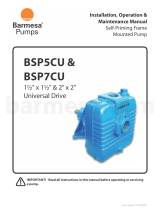
9
SPECIFICATIONS
Read this manual carefully before attempting to use this equipment. The potential for property damage, personal
injury or death exists if this equipment is misused or installed incorrectly. Read all of the manuals included with this
unit. Each manual details specific information regarding items such as set up, use and service requirements.
SPECIFICATIONS ARE SUBJECT TO CHANGE WITHOUT NOTICE.
MAGNUM MODEL MTP4000S
Engine:
Make/Brand, Model........................................................................................................ John Deere, PE4024TF281
Type ............................................................................................................................... Diesel, liquid cooled, 4-stroke
Displacement in
3
(L) ..................................................................................................... 149 (2.4)
Cylinders - qty ................................................................................................................ 4
Eng Rated Speed rpm .................................................................................................. 2800
Eng Pwr @ Rated Speed - Int. hp (kW)......................................................................... 49.0 (36.0)
Eng Pwr @ Rated Speed - Cont. hp (kW) .................................................................... 41.0 (30.8)
Eng Operating Speed rpm ............................................................................................ 2200
Eng Pwr @ Oper. Speed - Int. hp (kW) ........................................................................ 46.0 (34.1)
Eng Pwr @ Oper. Speed - Cont. hp (kW) ..................................................................... 39.0 (29.0)
Fuel Consumption - 100% load gph (Lph) ................................................................... 2.0 (7.6)
Battery Type - Group Number........................................................................................ 24
Battery Voltage (Quantity per Unit) ................................................................................ 12V (1)
Battery Rating ................................................................................................................ 720 CCA
Pump:
Make/Brand.................................................................................................................... Pioneer Pump Inc.
Model ............................................................................................................................. ES4
Fitting Size ..................................................................................................................... 4" NPTF
Impeller Material ............................................................................................................ ASTM A536 Ductile Iron
Impeller Diameter in (mm) ............................................................................................ 9.75 (248)
Shaft Material................................................................................................................. 17-4 PH Stainless Steel
Volute Material ............................................................................................................... ASTM A536 Ductile Iron
Wear Plate Material........................................................................................................ ASTM A48 Ductile Iron
Pump Set (Engine/Pump):
Maximum Diameter of Solids in (mm) .......................................................................... 3.0 (76.2)
Maximum Pump Output gpm (Lpm) ............................................................................. 1150 (4353)
Maximum Lift Suction ft (m) .......................................................................................... 25 (8)
Maximum Operating Speed rpm ................................................................................... 2000
Total Dynamic Head ft (m) ............................................................................................ 140 (42)
Sound dB(a) 23 ft. @ prime.......................................................................................... 79
Dimensions:
Skid Mounted in (m) ..................................................................................................... 82 x 35 x 60 (2.08 x .089 x 1.52)
Trailer Mounted in (m) .................................................................................................. 138 x 57 x 78 (3.51 x 1.45 x 1.98)
Weights:
Dry Weight, Skid Mounted ............................................................................................. 2407 (1091)
Operating Weight, Skid Mounted ................................................................................... 3199 (1451)
Dry Weight, Trailer Mounted .......................................................................................... 2957 (1341)
Operating Weight, Trailer Mounted ................................................................................ 3749 (1701)
Capacities:
Fuel Tank Volume gal (L) .............................................................................................. 110 (416)
Usable Fuel Volume gal (L) .......................................................................................... 95 (360)
Coolant (incl. engine) qt (L) .......................................................................................... 11.0 (10.4)
Oil (incl. filter) qt (L) ...................................................................................................... 8.5 (8.0)
Maximum Run Time hrs ............................................................................................... 48
Trailer:
Number of Axles ............................................................................................................ 1
Capacity - Axle Rating lbs (kg)
..................................................................................... 5000 (2268)
Tire Size in .................................................................................................................... 15
Brakes............................................................................................................................ Surge
Hitch - Standard ............................................................................................................. 2" Ball
Maximum Tire Pressure psi .......................................................................................... 65





















